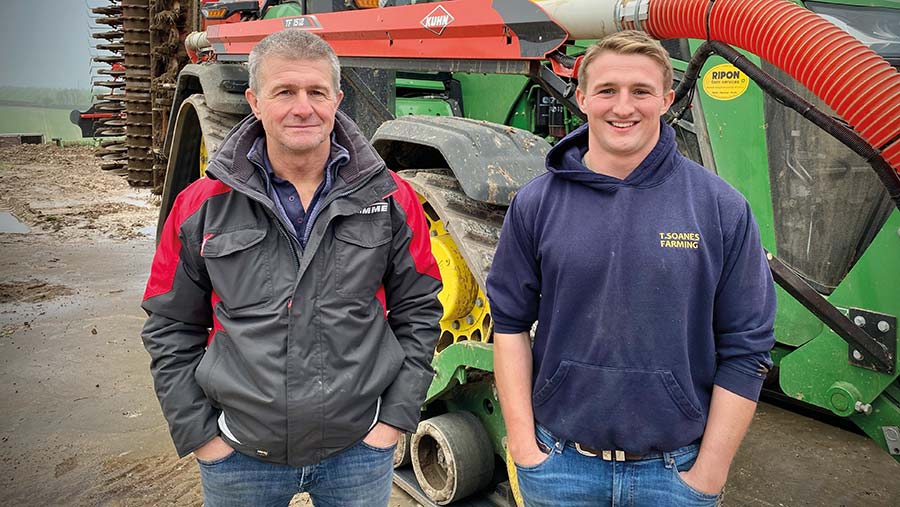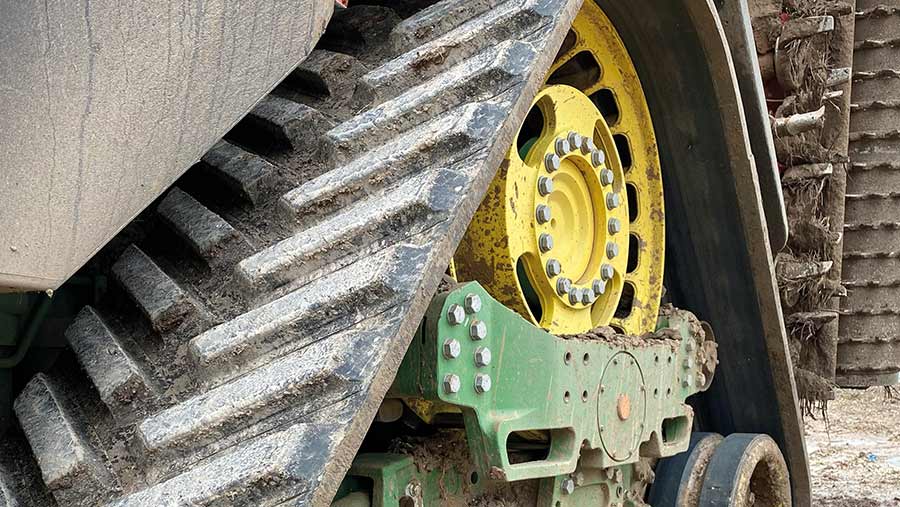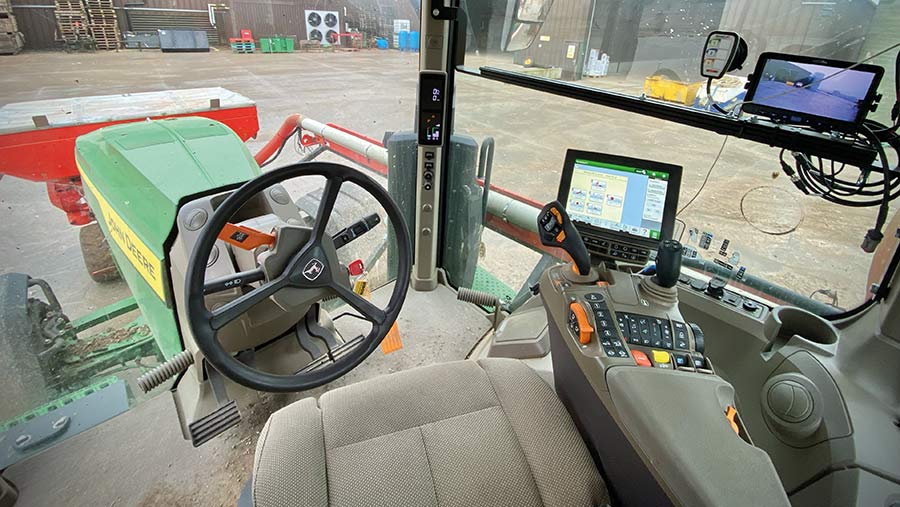Driver’s view: Soanes Farming rates its John Deere 8RX 370 tractor
 © MAG/Oliver Mark
© MAG/Oliver Mark John Deere’s 8-series tractors come in all shapes and sizes so, no matter whether you prefer four wheels, four tracks or two, there should be something that fits the bill – at least until price is pencilled into the equation.
The most recent addition is the RX featured here – a purpose-built four-tracker launched three years ago that almost instantly killed demand for retrofit kits from the likes of Soucy and Camso.
Highlights included a new front axle, bigger backend and more ground clearance, with the engine and transmission said to be the only major components shared with the established 8-series campaigners – the conventional R and twin-track RT.
See also: John Deere tractors: Common problems and how to fix them
While a track might not be able to match a tyre for speed and versatility, the RX has a significantly larger footprint, lower ground pressure and a tighter turning circle.
It also doesn’t require a special licence to drive it on the road, scuff on the headland, or spin in the wet – unlike the RT.

Andrew and John Soanes © MAG/Oliver Mark
Farm facts
- Size 2,400ha (1,200ha owned, plus rented and contract farming agreements)
- Crops 485ha potatoes, wheat, oilseed rape, winter barley, spring barley and vining peas
- Soil types Range from chalk/flint on the Wolds to heavy clay
- Other tractors John Deere 8370R, 6250R, 6215R, 6195R x3, 6190R, 6150R, JCB Fastrac 4220 x2
There’s a price to pay though, with the RX costing roughly 6% more than the twin-tracker and 32% more than good, old-fashioned wheels.
That didn’t deter Andrew and John Soanes of Yorkshire-based T Soanes & Son, who bought their first 8RX 370 two years ago.
Now on 2,600 hours, it is run alongside a wheeled 8370R and a second RX that has clocked 500 hours since arriving in July.
John Deere 8RX 370
- Year 2020
- Engine 9-litre, six-cylinder John Deere
- Max power 407hp (420hp boosted)
- Torque 1,732Nm@1,600rpm
- Transmission AutoPowr CVT, 40kph
- Weight 18,700kg
- Rear lift 9,000kg
- Price paid £250,000 (2022 model was £295,000)
Why did you pick an 8RX 370?
Our previous wheeled 8R had hit the 5,000-hour mark, which tends to be our cue to swap them, and John Deere had just launched the 8RX.
We’d always liked the idea of a conventional tractor with tracks, so we had the RX in for a demo on some winter ploughing. That sold it to us.
There was no easy way of justifying the extra cost over wheels, but our gut feeling was that it would suit our system well.
That’s partly because we still do a lot of intensive cultivations with implements that require 350-400hp on the front, but also due to the potential of the tracks to reduce soil compaction.
We used to dual-up our wheeled tractors, though escorting them down the road got a bit tedious.
The other reason why the RX appealed is that cultivations and drilling are pretty much all we need them for – we’ve got plenty of 6R Deeres and the two 4220 Fastracs for haulage, destoning and potato planting, so we’re not looking for versatility.
If there was a downside, it was that we had to go for the 370, as the 410 was only available with a powershift transmission and we need a CVT for the potato work.
Did you look at other options?
We’ve always had John Deere tractors – aside from a dalliance with Challenger that ended when the machines started falling to bits – so our options were limited.
The RTs were good tractors in certain situations, but they had a habit of veering off course as the tracks started to slip and, when pushed hard, the front end often lifted off the ground.
They also used to screw around on the headlands, which was obviously no good for drilling.
Alternatively, there’s the articulated 9RX, but it is way too big for us and we’d have to upgrade all our kit to match it.
The first 8RX came at the same time as a wheeled 8370R, and our preference is clear in the hour count – the RX has clocked 2,600 hours, while the conventional R is on 1,800.
iven the tracked tractors are now doing the lion’s share of work, we could probably downsize it to a 7R.
How has it performed?
The RXs will each average about 1,200 hours/year, primarily on top work as we ease away from ploughing, and so far they’ve been largely trouble-free.
We’ve upgraded the Vaderstad Topdown from 5m to 6m, as the four-track setup provides better traction and puts more power to the ground than both the old RT and the regular R-series.
On that job it’ll typically drink about 15 litres/ha or 60 litres/hour.
However, the extra power offered by the 8RX 410 would come in handy and, given it is now available with a stepless gearbox (the electric variable transmission), we’ll probably opt for it next time.

© MAG/Oliver Mark
The 370 is fine on the lighter Wold land, where it can hit 12kph with the Topdown relatively comfortably, but that drops to 10kph or less on the heavier ground.
For drilling oilseed rape, we use a Grange Machinery toolbar and 6m Vaderstad Rapid – a combination that wants every last drop of power.
But we’ve found the extra weight on the RX over the standard R keeps wheel slip at about 5% or lower, and that’s without a weight block on the front linkage.
As we had hoped, soil compaction is far less of a problem too, and it’s now quite rare to see the tractor’s wheelings through the field.
As a result, we’re getting more even emergence and fuller crops on the headland when the ground is wet – even compared with the 8R shod on massive 900s set at 12-15psi.
And there’s minimal scuffing – particularly compared with the RT.
The engine and transmission have been faultless, and niggles have been limited to tightening the odd loose fitting.
The only breakdown of any significance was when a link arm casting sheared off while we were ploughing, which was unfortunate.
Does it give a comfortable ride?
It’s surprisingly good and far less wallowy than the RT – even with a 6m combi drill hanging off the back.
However, we’ve really struggled with track longevity, and we’re not the only ones having problems.
We had our RT for four years and, 4,000 hours later, it left on the same tracks that it came with. Though they were worn out by the end, they had deep cleats that seemed to handle our flinty Wold ground reasonably well.
By comparison, the tracks on the RXs are barely managing one-quarter of that. The original set of rears lasted 1,200 hours, the front ones were replaced at 1,500 hours, and we’ve just had another set of rears at 2,400 hours.
Fortunately, John Deere has paid for all of them so far.

© MAG/Oliver Mark
Deere says they’re not lasting because they are getting too hot when travelling on the road, but we already dial down the top speed to 35kph whenever we’ve got a big mounted implement on the back to reduce the strain on the rear axle and track units.
And although we might travel up to 20 miles from the yard, we’re spending far more time in the field than on the road.
To try to extend their life, Deere has now fitted extra idlers on the back tracks to effectively “dual-up” and widen the original arrangement.
This will hopefully get rid of the weak spot, which tended to develop in line with the shoulder of the main rear idler and cause the track to split.
Other than that, it’s good to drive and, thanks to the cab suspension, the ride isn’t much different to a wheeled tractor.
The top speed is about 42kph, which is fast enough for the back roads in our area, but does mean it’s not quite as versatile for general farm tasks.
Though the cab in the old 8RT probably had the edge, at least in size, the RX is comfortable to drive, has decent footrests and the screen is easy to use.
Likes and gripes
✔ Reduced soil compaction
✔ Puts its power to the ground well
✔ Tight turning circle
✔ Trouble-free engine and transmission
✘ 43kph top speed
✘ Tracks don’t last long
✘ Less versatile than wheeled version
✘ Cab doesn’t seem as big as the old 8RT
